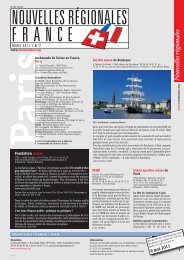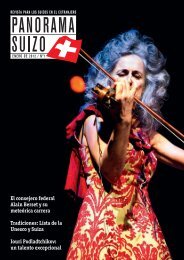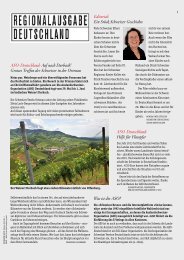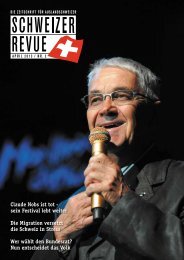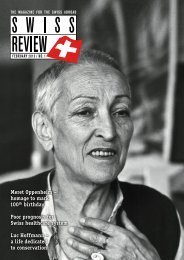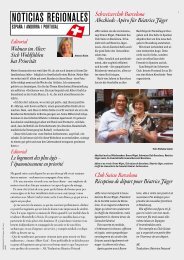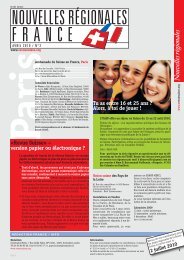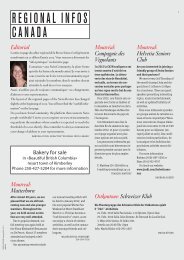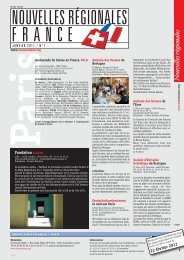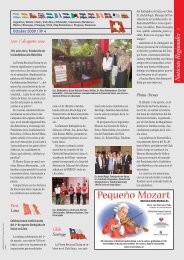Download PDF Swiss Review 6/2012 Low ... - Schweizer Revue
Download PDF Swiss Review 6/2012 Low ... - Schweizer Revue
Download PDF Swiss Review 6/2012 Low ... - Schweizer Revue
You also want an ePaper? Increase the reach of your titles
YUMPU automatically turns print PDFs into web optimized ePapers that Google loves.
14 CULTURE<br />
SWISS REVIEW December <strong>2012</strong> / No. 6<br />
Image: The Bridgeman Art Library<br />
National Museum<br />
In capitalism’s toolbox<br />
Outside, people are discussing disaster on the financial markets, but inside the <strong>Swiss</strong> National Museum<br />
in Zurich the talk is of cashless transactions in the Middle Ages and other famous discoveries. In the exhibition<br />
entitled “Capital”, the museum explores the origins of our economy.<br />
By Daniel Di Falco<br />
It almost appears as though organ transplants<br />
were already being carried out back<br />
in 1506. The heart in the wooden box, lying<br />
on a bed of metal elements, is red and bulging.<br />
The only problem is that the donor is<br />
not quite dead yet. He lies on his death bed<br />
with a bandaged head and looking as pale as<br />
a ghost. His loved ones stand around him<br />
wailing and imploring.<br />
The heart belongs to the dying man and<br />
it really has left his body. But the container<br />
is not a transplant box but a treasure<br />
chest and the shining metal inside is<br />
the money for which the wealthy man has<br />
sold his soul. The scene, painted by the<br />
artist Hans Fries in the late Middle Ages<br />
on the wing of an altar, depicts a cautionary<br />
sermon in the Franciscan spirit dedicated<br />
to poverty and charity. The line<br />
from the Gospel of Matthew is: “For<br />
where your treasure is, there your heart<br />
will be also.” Can wealth therefore be a<br />
sin? The question is asked mischievously<br />
here. That is because the entire exhibition,<br />
which starts with the warning about<br />
money, focuses on the triumph and blessing<br />
of capitalism, the economic system<br />
that has conquered the world in spite of<br />
Franciscan morality and fear of the loss of<br />
salvation. It is driven by the maximisation<br />
of profits not moderation.<br />
Where it all began<br />
“Capital” – a simple and striking title for<br />
an exhibition. And it has come at just the<br />
right moment as even capitalists are talking<br />
about capitalism. This economic system<br />
has ceased to be accepted without<br />
question; it has become open to debate<br />
again. Where did capitalism come from?<br />
Why did the markets emerge? How did the<br />
financial system develop? “We are all only<br />
too willing to voice our opinions on the<br />
economy but know much too little about<br />
its origins”, says Walter Keller, publisher,<br />
cultural publicist and guest curator at the<br />
<strong>Swiss</strong> National Museum, in reference to<br />
his exhibition.<br />
He has traced the origins of our economy<br />
to the late Middle Ages and the early modern<br />
period in Venice and Amsterdam. The<br />
nascent period of capitalism took place during<br />
the rise of these pre-modern economic<br />
powers; not in industry at this stage, but instead<br />
in the field of commerce. But globalisation<br />
existed even then, as did shares, gov-<br />
taining loose rods of ivory with grooved sequences<br />
of numbers, which enabled Venetian<br />
tradesmen to carry out simple<br />
calculations. A manual from 1525 contains<br />
illustrated instructions for a sign language<br />
that allowed three and four-digit amounts<br />
to be expressed on one hand. There is also a<br />
folding sundial for travelling, as well as ta-<br />
Two men who played a key role in world trade in the 16th and 17th centuries: Dutch ambassador Cornelius von der Mijle<br />
ernment debt and financial markets. The<br />
exhibition organisers underline the fact that<br />
while this period of history was centuries<br />
ago it is remarkably topical.<br />
The long, winding route through the exhibition<br />
designed by Walter Keller and the<br />
scenographer Raphael Barbier covers several<br />
floors and passes through closets, rooms<br />
and corridors. It takes about two hours to<br />
see everything. Visitors will often find<br />
themselves standing and staring in amazement.<br />
One of the exhibits, for example, is a<br />
pocket calculator from the 17th century – an<br />
unadorned casket made of boxwood con-<br />
bles with foreign alphabets and currencies,<br />
sea charts and nautical equipment.<br />
Silk, salt and slaves<br />
What the exhibition so impressively displays<br />
is the toolbox of an empire – the instruments<br />
of an internationalised economy<br />
that one would hardly have expected<br />
at such an early time. Venice was initially<br />
a set of isolated islands in the brackish waters<br />
of the Adriatic Sea populated by refugees<br />
from the ruins of the Roman Empire.<br />
This city republic nevertheless rose<br />
to become a global power in the Middle



